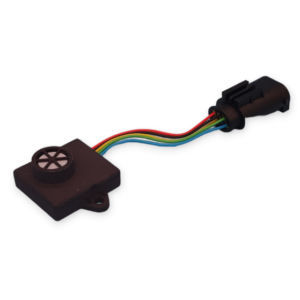
Conductivity sensor PGS1000gashydrogenmedical
Add to favorites
Compare this product
Characteristics
- Evaluation type
- conductivity, gas, hydrogen
- Applications
- medical
Description
The PGS1000 series of hydrogen sensors detects hydrogen concentration in air by measuring the change in thermal conductivity of the gas mixture. Hydrogen and air have very different thermal conductivity. Variation in hydrogen concentration results in significant changes in the thermal conductivity of the gas mixture. The PGS1000 series uses Posifa's second generation thermal conductivity die that is packaged in an SMD form factor. It uses two thermal conductivity dies in a differential configuration: one sealed in dry air and acting as a reference; the other exposed to the gas mixture. Such a design achieves an excellent signal-to-noise ratio due to common-mode noise rejection and maximizatin of signal amplification. In addition, the sensor is excited with a pulsed waveform (400 ms on and 1000 ms off), resulting in a heater temperature that is almost the same as the ambient. This ferature lends the sensor to intrinct safety.
Like any thermal-conductivit-based hydrogen sensors, Posifa sensors are subject to specific cross sensitivity with other gases whose thermal conductivity are also significantly different from that of air, such as humidity, and hydrocarbon gases (e.g. methane). Therefore Posifa's hydrogen sensors perform optimally in applications where interfering gases are absent, or their cross sensitivity is within acceptable margin of error required by the application.
When deployed in a suitable environment, Posifa's MEMS thermal conductivity hydrogen sensor is superior to competing technologies. It is fast responding, long-term stable, and low cost.
FEATURES
• Broadest available ranges, up to 100% vol
• Fast response time < 1.4 s
• Temperature compensation
Catalogs
No catalogs are available for this product.
See all of BS-rep GmbH‘s catalogsRelated Searches
- Medical probe
- Temperature probe
- Monitoring probe
- Gas probe
- Analyzer for the pharmaceutical industry
- Temperature analyzer
- Pressure sensor
- Flow probe
- Oxygen probe
- Humidity probe
- Process probe
- Conductivity probe
- Anesthesia equipment probe
- In-line analyzer
- Mass flow sensor
- Bubble point analyzer
- Hydrogen sensor
- Ultrasonic analyzer
- Vacuum pressure sensor
*Prices are pre-tax. They exclude delivery charges and customs duties and do not include additional charges for installation or activation options. Prices are indicative only and may vary by country, with changes to the cost of raw materials and exchange rates.


